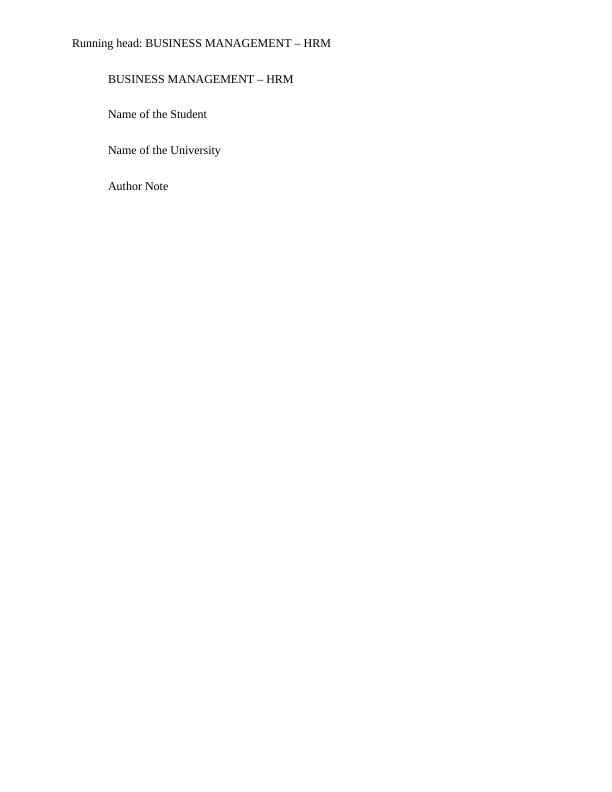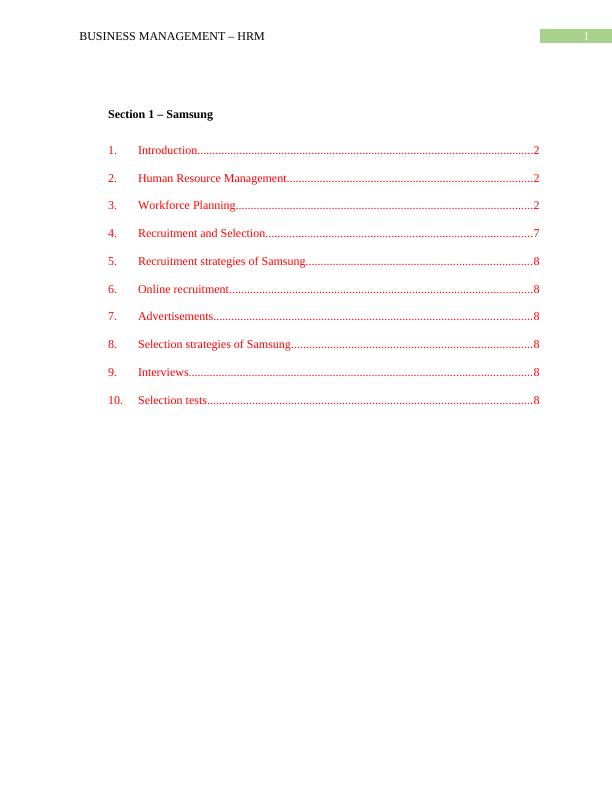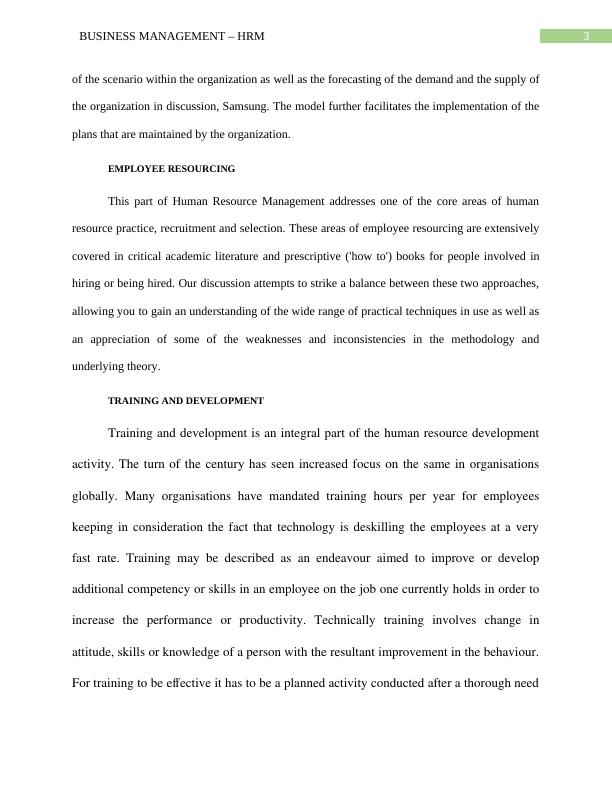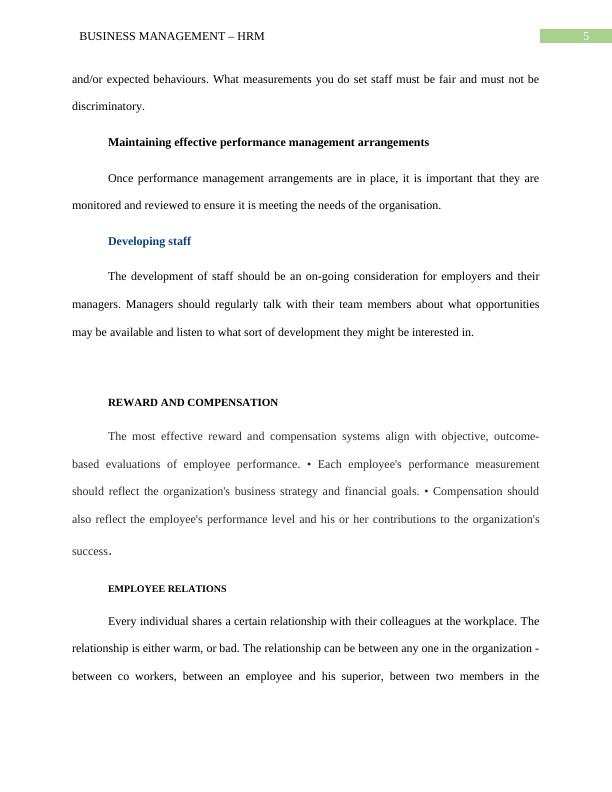Business Management - HRM
22 Pages4100 Words207 Views
Added on 2023-04-19
About This Document
This article discusses the practices of HRM in Business Management, focusing on Samsung and BBC. It covers topics such as workforce planning, recruitment and selection strategies, training and development, reward management, performance management, and flexible working practices. Find study material and solved assignments on Desklib.
Business Management - HRM
Added on 2023-04-19
ShareRelated Documents
Running head: BUSINESS MANAGEMENT – HRM
BUSINESS MANAGEMENT – HRM
Name of the Student
Name of the University
Author Note
BUSINESS MANAGEMENT – HRM
Name of the Student
Name of the University
Author Note

1BUSINESS MANAGEMENT – HRM
Section 1 – Samsung
1. Introduction................................................................................................................2
2. Human Resource Management..................................................................................2
3. Workforce Planning...................................................................................................2
4. Recruitment and Selection.........................................................................................7
5. Recruitment strategies of Samsung...........................................................................8
6. Online recruitment.....................................................................................................8
7. Advertisements..........................................................................................................8
8. Selection strategies of Samsung................................................................................8
9. Interviews..................................................................................................................8
10. Selection tests............................................................................................................8
Section 1 – Samsung
1. Introduction................................................................................................................2
2. Human Resource Management..................................................................................2
3. Workforce Planning...................................................................................................2
4. Recruitment and Selection.........................................................................................7
5. Recruitment strategies of Samsung...........................................................................8
6. Online recruitment.....................................................................................................8
7. Advertisements..........................................................................................................8
8. Selection strategies of Samsung................................................................................8
9. Interviews..................................................................................................................8
10. Selection tests............................................................................................................8

2BUSINESS MANAGEMENT – HRM
1. Introduction
A South Korean multinational conglomerate, Samsung, was founded in the year 1938. It
is the largest operating conglomerate in the region of South Korea and is known to have been
comprising of the several affiliated businesses (Samsung.com 2019). The effective practices of
HRM is crucial for the proper performance of the company in the given international markets.
2. Human Resource Management
The human resource management within the organization refers to the management of the
workforces who have been serving the concerned company at the given locations wherein the
company has been operating (Russell and Brannan 2016). The major functions of the HRM
within the company include the planning of the workforce, the selection and the recruitment of
the potential employees as well as training them as and when it is necessary.
The seven main function of HR as follow
3. Workforce Planning
The workforce planning within the organization refer to the continual processes that are
utilized by the human resource department within the given organization so that the concerned
employees can meet all the legislative as well as the service requirements that are highlighted by
the organization through the objectives that have been set by the company (de Leeuw and Wiers
2015). The purpose of the workforce planning is to maintain a proper harmony within the
organization. The workforce planning activities tend to help in the maintenance of the staffing at
the proper departments and posts within the organization.
The workforce planning model as implemented by Samsung helps in the discussion on
the ways in which the company aims to integrate the business plan, the action plan, the planning
1. Introduction
A South Korean multinational conglomerate, Samsung, was founded in the year 1938. It
is the largest operating conglomerate in the region of South Korea and is known to have been
comprising of the several affiliated businesses (Samsung.com 2019). The effective practices of
HRM is crucial for the proper performance of the company in the given international markets.
2. Human Resource Management
The human resource management within the organization refers to the management of the
workforces who have been serving the concerned company at the given locations wherein the
company has been operating (Russell and Brannan 2016). The major functions of the HRM
within the company include the planning of the workforce, the selection and the recruitment of
the potential employees as well as training them as and when it is necessary.
The seven main function of HR as follow
3. Workforce Planning
The workforce planning within the organization refer to the continual processes that are
utilized by the human resource department within the given organization so that the concerned
employees can meet all the legislative as well as the service requirements that are highlighted by
the organization through the objectives that have been set by the company (de Leeuw and Wiers
2015). The purpose of the workforce planning is to maintain a proper harmony within the
organization. The workforce planning activities tend to help in the maintenance of the staffing at
the proper departments and posts within the organization.
The workforce planning model as implemented by Samsung helps in the discussion on
the ways in which the company aims to integrate the business plan, the action plan, the planning

3BUSINESS MANAGEMENT – HRM
of the scenario within the organization as well as the forecasting of the demand and the supply of
the organization in discussion, Samsung. The model further facilitates the implementation of the
plans that are maintained by the organization.
EMPLOYEE RESOURCING
This part of Human Resource Management addresses one of the core areas of human
resource practice, recruitment and selection. These areas of employee resourcing are extensively
covered in critical academic literature and prescriptive ('how to') books for people involved in
hiring or being hired. Our discussion attempts to strike a balance between these two approaches,
allowing you to gain an understanding of the wide range of practical techniques in use as well as
an appreciation of some of the weaknesses and inconsistencies in the methodology and
underlying theory.
TRAINING AND DEVELOPMENT
Training and development is an integral part of the human resource development
activity. The turn of the century has seen increased focus on the same in organisations
globally. Many organisations have mandated training hours per year for employees
keeping in consideration the fact that technology is deskilling the employees at a very
fast rate. Training may be described as an endeavour aimed to improve or develop
additional competency or skills in an employee on the job one currently holds in order to
increase the performance or productivity. Technically training involves change in
attitude, skills or knowledge of a person with the resultant improvement in the behaviour.
For training to be effective it has to be a planned activity conducted after a thorough need
of the scenario within the organization as well as the forecasting of the demand and the supply of
the organization in discussion, Samsung. The model further facilitates the implementation of the
plans that are maintained by the organization.
EMPLOYEE RESOURCING
This part of Human Resource Management addresses one of the core areas of human
resource practice, recruitment and selection. These areas of employee resourcing are extensively
covered in critical academic literature and prescriptive ('how to') books for people involved in
hiring or being hired. Our discussion attempts to strike a balance between these two approaches,
allowing you to gain an understanding of the wide range of practical techniques in use as well as
an appreciation of some of the weaknesses and inconsistencies in the methodology and
underlying theory.
TRAINING AND DEVELOPMENT
Training and development is an integral part of the human resource development
activity. The turn of the century has seen increased focus on the same in organisations
globally. Many organisations have mandated training hours per year for employees
keeping in consideration the fact that technology is deskilling the employees at a very
fast rate. Training may be described as an endeavour aimed to improve or develop
additional competency or skills in an employee on the job one currently holds in order to
increase the performance or productivity. Technically training involves change in
attitude, skills or knowledge of a person with the resultant improvement in the behaviour.
For training to be effective it has to be a planned activity conducted after a thorough need

4BUSINESS MANAGEMENT – HRM
analysis and target at certain competencies, most important it is to be conducted in a
learning atmosphere.
PERFORMANCE MANAGEMENT
Performance management describes the arrangements that employers use to maintain,
and improve the performance of their workforce so that the organisation achieves its goals. Most
performance management arrangements involve employees being set performance measurements
meetings between a manager and each member of staff to discuss their performance assessing
employees against their performance measures a record of performance being kept.
Why is managing performance important?
Good performance management is essential to get the best outcome for organisations and
the workforce. If performance is not managed well, staff are unlikely to perform at their best.
Good performance management arrangements can help an organisation by motivate staff
and check that all staff are making valuable contributions towards organisational goals and
develop staff recognise and acknowledge the good work of employees and deliver tasks and
projects quickly and to required standards to spot and improve poor performance.
However, it is important to keep the arrangements as simple as possible, so that managers
and staff do not work around it.
Measuring staff performance
Measured and assessed can be difficult for employers to get right. Staff should be set
challenging performance measurements. This might involve setting your employees objectives
analysis and target at certain competencies, most important it is to be conducted in a
learning atmosphere.
PERFORMANCE MANAGEMENT
Performance management describes the arrangements that employers use to maintain,
and improve the performance of their workforce so that the organisation achieves its goals. Most
performance management arrangements involve employees being set performance measurements
meetings between a manager and each member of staff to discuss their performance assessing
employees against their performance measures a record of performance being kept.
Why is managing performance important?
Good performance management is essential to get the best outcome for organisations and
the workforce. If performance is not managed well, staff are unlikely to perform at their best.
Good performance management arrangements can help an organisation by motivate staff
and check that all staff are making valuable contributions towards organisational goals and
develop staff recognise and acknowledge the good work of employees and deliver tasks and
projects quickly and to required standards to spot and improve poor performance.
However, it is important to keep the arrangements as simple as possible, so that managers
and staff do not work around it.
Measuring staff performance
Measured and assessed can be difficult for employers to get right. Staff should be set
challenging performance measurements. This might involve setting your employees objectives

5BUSINESS MANAGEMENT – HRM
and/or expected behaviours. What measurements you do set staff must be fair and must not be
discriminatory.
Maintaining effective performance management arrangements
Once performance management arrangements are in place, it is important that they are
monitored and reviewed to ensure it is meeting the needs of the organisation.
Developing staff
The development of staff should be an on-going consideration for employers and their
managers. Managers should regularly talk with their team members about what opportunities
may be available and listen to what sort of development they might be interested in.
REWARD AND COMPENSATION
The most effective reward and compensation systems align with objective, outcome-
based evaluations of employee performance. • Each employee's performance measurement
should reflect the organization's business strategy and financial goals. • Compensation should
also reflect the employee's performance level and his or her contributions to the organization's
success.
EMPLOYEE RELATIONS
Every individual shares a certain relationship with their colleagues at the workplace. The
relationship is either warm, or bad. The relationship can be between any one in the organization -
between co workers, between an employee and his superior, between two members in the
and/or expected behaviours. What measurements you do set staff must be fair and must not be
discriminatory.
Maintaining effective performance management arrangements
Once performance management arrangements are in place, it is important that they are
monitored and reviewed to ensure it is meeting the needs of the organisation.
Developing staff
The development of staff should be an on-going consideration for employers and their
managers. Managers should regularly talk with their team members about what opportunities
may be available and listen to what sort of development they might be interested in.
REWARD AND COMPENSATION
The most effective reward and compensation systems align with objective, outcome-
based evaluations of employee performance. • Each employee's performance measurement
should reflect the organization's business strategy and financial goals. • Compensation should
also reflect the employee's performance level and his or her contributions to the organization's
success.
EMPLOYEE RELATIONS
Every individual shares a certain relationship with their colleagues at the workplace. The
relationship is either warm, or bad. The relationship can be between any one in the organization -
between co workers, between an employee and his superior, between two members in the

End of preview
Want to access all the pages? Upload your documents or become a member.
Related Documents
Human Resource Management in Samsung and BBClg...
|27
|6552
|245
Benefits of HRM practices for employees and employerslg...
|16
|5389
|2
Benefits of HRM Practices for Employers and Employeeslg...
|24
|5626
|6
Assessing the Purpose and Function of HRM in Samsunglg...
|22
|5054
|11
Human Resource Management in Samsunglg...
|16
|3780
|55
Human Resource Managementlg...
|17
|4255
|5
